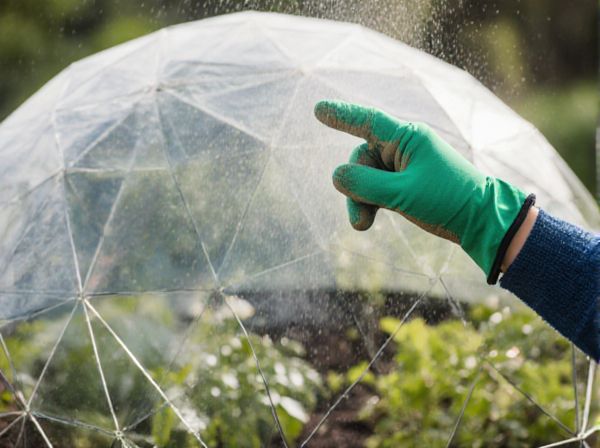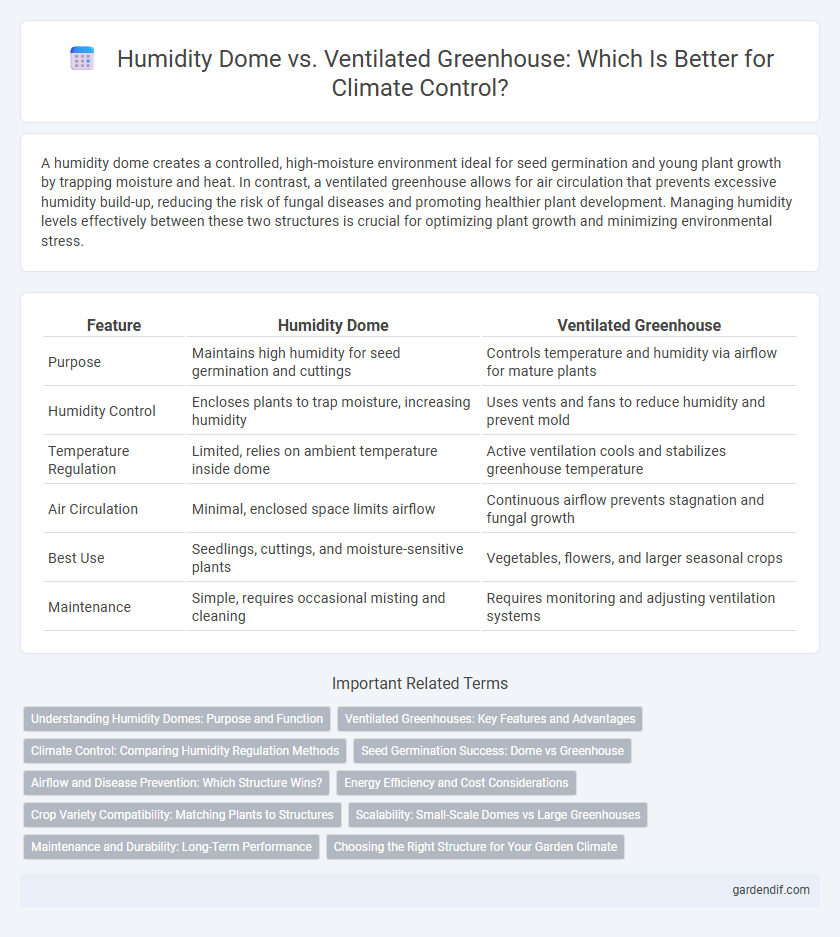
Humidity dome vs Ventilated greenhouse Illustration
A humidity dome creates a controlled, high-moisture environment ideal for seed germination and young plant growth by trapping moisture and heat. In contrast, a ventilated greenhouse allows for air circulation that prevents excessive humidity build-up, reducing the risk of fungal diseases and promoting healthier plant development. Managing humidity levels effectively between these two structures is crucial for optimizing plant growth and minimizing environmental stress.
Table of Comparison
| Feature | Humidity Dome | Ventilated Greenhouse |
|---|---|---|
| Purpose | Maintains high humidity for seed germination and cuttings | Controls temperature and humidity via airflow for mature plants |
| Humidity Control | Encloses plants to trap moisture, increasing humidity | Uses vents and fans to reduce humidity and prevent mold |
| Temperature Regulation | Limited, relies on ambient temperature inside dome | Active ventilation cools and stabilizes greenhouse temperature |
| Air Circulation | Minimal, enclosed space limits airflow | Continuous airflow prevents stagnation and fungal growth |
| Best Use | Seedlings, cuttings, and moisture-sensitive plants | Vegetables, flowers, and larger seasonal crops |
| Maintenance | Simple, requires occasional misting and cleaning | Requires monitoring and adjusting ventilation systems |
Understanding Humidity Domes: Purpose and Function
Humidity domes create a controlled microenvironment by trapping moisture and warmth around seedlings, promoting faster germination and reducing water loss. They maintain high relative humidity to prevent desiccation, supporting young plants' delicate development stages. Unlike ventilated greenhouses that regulate airflow to prevent overheating and mold, humidity domes prioritize moisture retention for optimal seedling growth.
Ventilated Greenhouses: Key Features and Advantages
Ventilated greenhouses use strategically placed vents and fans to regulate temperature and humidity, creating an optimal growing environment by promoting air circulation and reducing excess moisture. This system prevents the formation of humidity domes, minimizing the risk of mold, fungal diseases, and heat stress in plants. Enhanced ventilation improves photosynthesis efficiency and supports consistent crop yield by maintaining stable microclimate conditions.
Climate Control: Comparing Humidity Regulation Methods
Humidity domes create a microclimate by trapping moisture and reducing evaporation, leading to higher humidity levels ideal for seed germination and delicate plants. Ventilated greenhouses use adjustable vents and fans to regulate air exchange, maintaining consistent humidity and preventing mold growth in larger or more varied plant collections. Effective climate control in greenhouses depends on matching humidity regulation methods to plant needs and environmental conditions for optimal growth and disease prevention.
Seed Germination Success: Dome vs Greenhouse
Humidity domes maintain elevated moisture levels and stable temperatures, creating an ideal microclimate for seed germination by preventing soil desiccation and promoting faster sprout development. Ventilated greenhouses offer controlled airflow and temperature regulation, reducing the risk of fungal diseases but may cause fluctuations in humidity that can slow germination rates. Studies show humidity domes typically yield higher seed germination success due to consistent moisture retention compared to ventilated greenhouses.
Airflow and Disease Prevention: Which Structure Wins?
Ventilated greenhouses provide superior airflow through adjustable vents that reduce humidity levels and inhibit the growth of mold and fungal diseases. Humidity domes, while effective in maintaining moisture for seed germination, can create stagnant air pockets that increase disease risk. For optimal disease prevention, structures promoting continuous air circulation like ventilated greenhouses are more advantageous.
Energy Efficiency and Cost Considerations
Humidity domes provide localized moisture control that reduces water evaporation, enhancing energy efficiency by minimizing the need for additional heating or cooling. Ventilated greenhouses employ natural airflow to regulate temperature and humidity, lowering energy consumption but often requiring higher initial investment due to structural complexity. Cost considerations favor humidity domes for small-scale or seedling applications, while ventilated greenhouses offer long-term savings for larger operations through improved climate control and reduced energy bills.
Crop Variety Compatibility: Matching Plants to Structures
Humidity domes create a high-moisture microclimate ideal for moisture-loving crops such as tropical plants and seedlings that require consistent humidity for germination and early growth. Ventilated greenhouses support a wider variety of crops by maintaining controlled airflow and temperature, preventing excess moisture that can cause fungal diseases, making them suitable for vegetables, herbs, and flowers with moderate humidity needs. Selecting the appropriate structure depends on the specific crop requirements for humidity, air circulation, and temperature control to optimize growth and yield.
Scalability: Small-Scale Domes vs Large Greenhouses
Humidity domes offer efficient humidity control ideal for small-scale applications such as seed starting and propagation, providing a compact environment that conserves moisture and reduces water usage. Large greenhouses with advanced ventilation systems enable scalable climate management, supporting diverse crops with tailored airflow, temperature regulation, and humidity control across extensive cultivation areas. Scalability favors ventilated greenhouses for commercial production, while humidity domes serve well in limited-space or early growth stages.
Maintenance and Durability: Long-Term Performance
Humidity domes require frequent cleaning and occasional seal replacements to maintain optimal moisture levels, leading to higher maintenance efforts over time. Ventilated greenhouses, built with durable materials and adjustable airflow systems, offer enhanced durability and reduced upkeep by preventing mold and structural wear. Long-term performance favors ventilated greenhouses due to their ability to sustain stable environments with minimal intervention.
Choosing the Right Structure for Your Garden Climate
A humidity dome creates a controlled, high-moisture environment ideal for seedlings that require consistent humidity to thrive, while a ventilated greenhouse allows for better airflow, reducing the risk of mold and overheating in warmer climates. Selecting the right structure depends on your local climate conditions and plant needs; high humidity zones benefit from domes to maintain moisture, whereas hot and humid regions favor ventilated greenhouses for temperature regulation. Understanding the balance between moisture retention and airflow is crucial to optimizing plant growth and preventing disease in your garden.
Humidity dome vs Ventilated greenhouse Infographic

 gardendif.com
gardendif.com